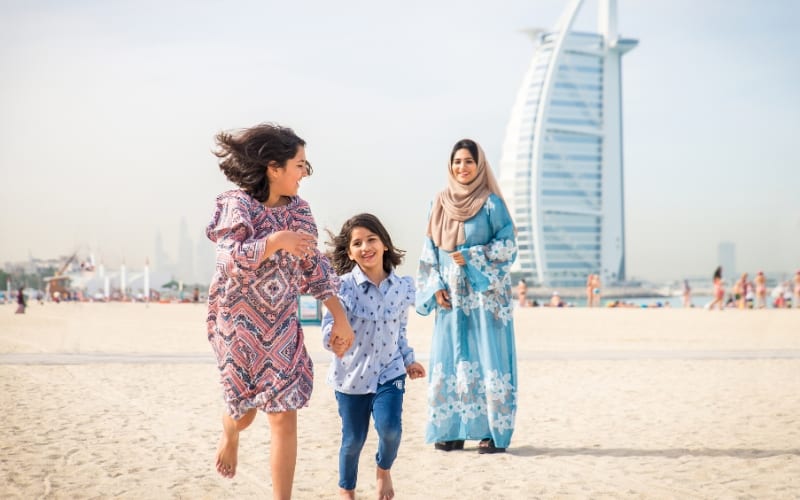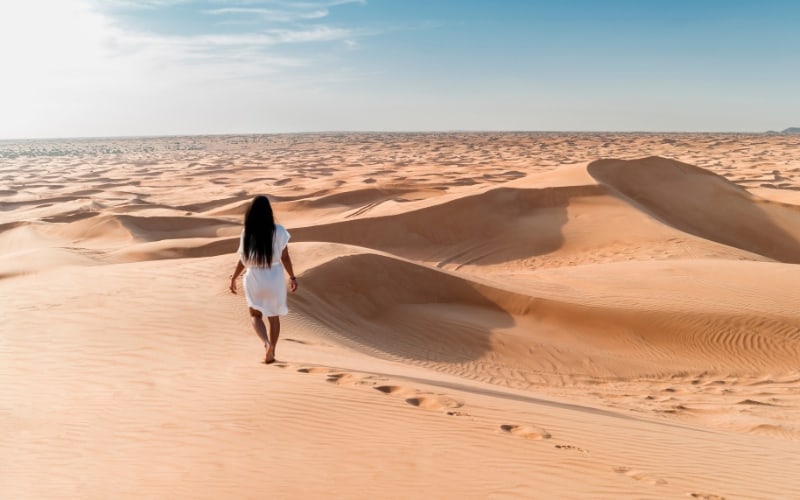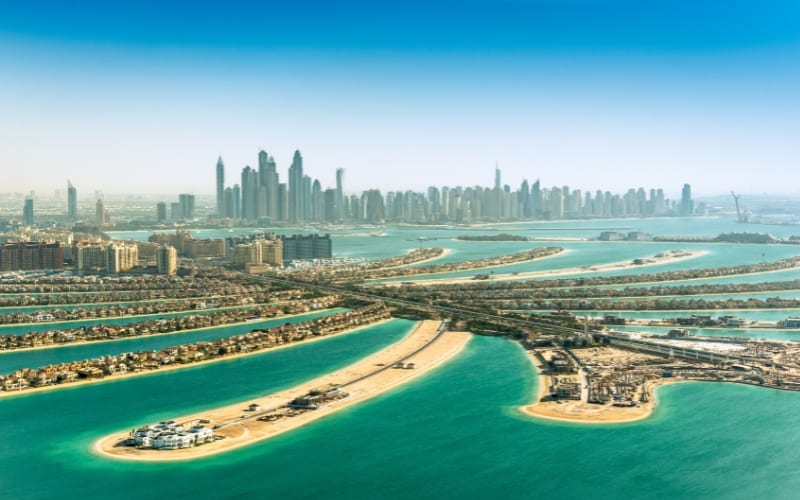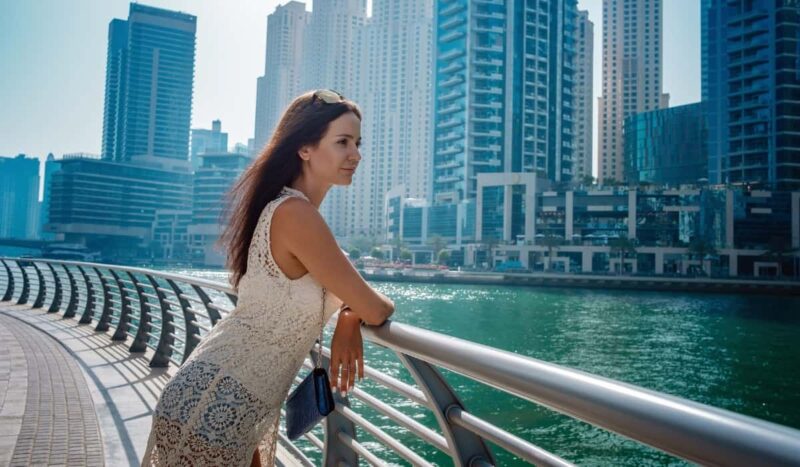When you consider the appeal of its skyscrapers, cultural richness, luxury and vibrant lifestyle, it’s easy to see why a growing number of expats are making the move to Dubai. Yet, as well as the obvious selling points, there is the challenge of living in a desert climate. From the sun drenched days that define the summer to the temperate and inviting winter months, you need to understand the nuances of Dubai’s climate. This will prepare you for the embrace of desert winds and the unique weather patterns that accompany them.
Whether you’re drawn by career opportunities, adventure or you are embracing a new chapter in your life, understanding the climate in Dubai is key. In this blog, we have taken a look at the seasons in Dubai, the climate’s impact on everyday life and how you can adapt to the heat.
What to Expect from Dubai’s Seasons

Dubai experiences a desert climate, characterised by hot temperatures and minimal rainfall. The city has two main seasons: a hot and arid summer, and a relatively milder winter. Though Dubai rarely experiences anything that would be described as cold weather, there are key differences between the temperature and humidity in both seasons.
Summer (May to September)
Summers in Dubai are extremely hot and dry, with temperatures often exceeding 40°C and occasionally reaching 45°C, or higher. Despite the high temperatures, the humidity levels are generally low, providing some relief compared to many other tropical climates. Rainfall during summer is minimal, and the region is characterised by arid conditions.
Winter (October to April)
Winters in Dubai are much milder compared to the scorching summers, and it’s a pleasant time to explore the area. Daytime temperatures range from around 20°C to 30°C, while nighttime temperatures can be cooler. Humidity levels are generally lower in winter, making the weather more comfortable. Dubai experiences most of its annual rainfall during the winter months. While it is still relatively low compared to other regions, occasional rainfall may occur.
Transition Seasons (Spring and Autumn)
Dubai only has two main seasons, summer and winter, but there are transition seasons between them. During spring – which runs from March to May – and autumn – which runs from September to November – temperatures are moderate, providing a transition between the extreme heat of summer and the milder winter months. During the transition seasons Dubai experiences dust storms. Known as “khamsin,” these dust storms bring dusty winds and reduced visibility.
It’s important to remember that temperatures in summer can be quite challenging for outdoor activities in Dubai, and you should take precautions to stay hydrated throughout the day. It’s also important to avoid prolonged exposure to the sun. Winters in Dubai are more pleasant, making it an ideal time for outdoor exploration and enjoying the city’s attractions.
The Climate in Dubai During Peak Tourism Season
Dubai experiences a consistent influx of tourists throughout the year, and this is due to its status as a global business and leisure hub. However, the winter months, specifically from October to April, are considered the peak tourism season.
During tourism season, the weather is relatively mild and comfortable, making it more conducive for outdoor activities and sightseeing. Tourists flock to Dubai to escape the harsh winter conditions in many other parts of the world and enjoy the city’s attractions, shopping and entertainment options.The peak tourism season is characterised by a surge in the number of visitors, leading to higher demand for accommodations, flights and various tourism related services.
When you are planning to move to Dubai, you need to consider the pros and cons of moving during the tourism season. Though the weather and temperature are favourable – the mild and pleasant days are a good way to slowly get used to the heat, rather than jumping straight into the heat and humidity that comes in the summer – a lot of services are more expensive. This could increase the cost of moving to Dubai, especially if you need to book short term accommodation whilst you get settled.
Tips on Dealing with the Weather in Dubai

It’s important to know how to adapt and acclimate to living in a hot country, especially if you are heading to Dubai, a place that has a completely different climate to the UK. Here are some of our top tips.
Stay Hydrated
Given the high temperatures, it’s important to stay hydrated in Dubai. Carry a water bottle with you, especially when exploring outdoor attractions or engaging in physical activities.
Dress Appropriately
Wear lightweight, loose fitting and light coloured clothing when you are in Dubai, as this will help you to reflect the sun’s rays. Suncream, sunglasses and a hat are also recommended to protect yourself from the intense sunlight.
Plan Outdoor Activities Wisely
Schedule outdoor activities during the early morning or late afternoon when temperatures are a lot cooler. Avoid outdoor exertion during the peak midday heat to prevent heat related issues, such as exhaustion.
Utilise Indoor Facilities
Dubai is equipped with world class indoor facilities. Many shopping centres, entertainment complexes and attractions are air conditioned, providing a comfortable escape from the outdoor heat.
Beach Time
If you plan to visit the beach, it’s advisable to do so in the early morning or late afternoon. The sand can become extremely hot during midday, making it uncomfortable for bare feet.
Stay Informed About the Weather
When you are in Dubai, you should keep an eye on weather forecasts to plan your activities accordingly. Dubai can experience sudden sandstorms, and being aware of the weather conditions can help you make informed decisions.
How Dubai is Built to Help with Heat

In the heart of the desert, where temperatures soar to scorching heights, Dubai stands as a testament to human ingenuity in the face of relentless heat. As a city that experiences a desert climate with long and hot summers, Dubai has employed innovative designs and technologies to create an oasis of comfort amid the challenging climate. I
Architectural Design
Many buildings in Dubai are designed with heat resistant materials and innovative architecture to minimise heat absorption. This design helps keep indoor spaces cooler.
Indoor Air Conditioning
Indoor spaces in Dubai are heavily air conditioned, providing a respite from the outdoor heat. Almost all public places, including shopping centres, hotels and public transport, have efficient air conditioning.
Shaded Pavements and Public Spaces
The city is designed with shaded pavements, parks and public spaces to provide shelter from the sun. These shaded areas offer a comfortable environment for outdoor activities.
Beach Facilities
Public beaches in Dubai often have amenities such as shaded areas, umbrellas and facilities for cooling off. These enhancements make beach visits more enjoyable, even in the heat.
Cooling Technologies
Some outdoor attractions – such as parks and theme parks – incorporate cooling technologies like misting systems to reduce temperatures and enhance the visitor experience.
Public Transport Options
Public transport, including the metro and buses, is air-conditioned. This makes it a comfortable way to travel around the city. Taxis are also readily available for a cooler mode of transport.
Planning Your Move to Dubai

As you prepare for your relocation to the vibrant city of Dubai, it’s essential to align your lifestyle and plans with Dubai’s hot and humid climate. Once you have made the decision to move to Dubai, the next step is to manage the logistics of moving your belongings, and that’s where we come in. At United International Removals, we ensure a seamless transition to your new home in the wonderful city of Dubai. Contact our helpful team to find out more.
